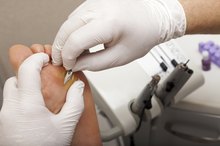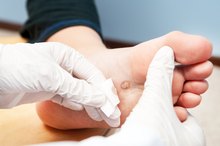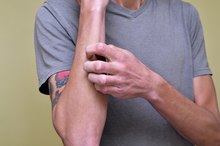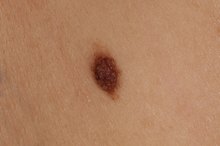Filiform warts are flesh-colored growths made of several thin fingerlike projections sitting on top of a thin or thick stalk. Filiform warts can grow anywhere but are most commonly found on the face — especially on or around the lips, nose or eyelids — or on the neck.
Filiform warts are caused by certain types of human papillomavirus (HPV): types 1, 2, 4, 27 and 29.
These are different from the types of HPV that cause genital warts or cancer. While contagious and unattractive, filiform warts are generally painless and will not develop into cancer.
Filiform warts do not always require treatment, but if treatment is chosen, they are usually easy to treat, according to Merck Manual. But no treatment completely removes all of the virus, so filiform warts can return, even after successful treatment.
First, See a Doctor
If you think you have a filiform wart, see a doctor to determine the diagnosis. It is important to be sure that you do not have skin cancer or another type of skin lesion.
Furthermore, because filiform warts usually appear on the face, any form of treatment must be performed with caution to reduce the chances of scarring. In fact, the American Academy of Dermatology recommends consultation with a dermatologist for any wart on the face 6.
- If you think you have a filiform wart, see a doctor to determine the diagnosis.
Consider No Treatment
Benzoyl Peroxide for Warts
Learn More
As many as 70 percent of warts will eventually go away on their own, according to eMedicineHealth 5. Because of this, you and your doctor may decide to avoid treatment, at least initially. But it can take months or years for warts to completely disappear and it is not possible to predict which warts will go away on their own. Therefore, many people opt for treatment.
- As many as 70 percent of warts will eventually go away on their own, according to eMedicineHealth.
Use OTC Treatments Only If Recommended
Medications containing salicylic acid, such as Compound W, are sold over-the-counter to treat warts 8.
While safe for most warts, these medications can be harmful if they enter the eyes, mouth or nose, and they may cause scarring. Only use these medications for filiform warts on the face if your doctor definitely recommends them for you.
Other over-the-counter medications, such as Dr. Scholl’s Freeze Away Wart Remover, can destroy warts by freezing them — a form of cryotherapy. These medications contain dimethyl ether and propane. They can also produce scarring and should only be used for filiform warts on the face if clearly recommended by your doctor.
- Medications containing salicylic acid, such as Compound W. While safe for most warts, these medications can be harmful if they enter the eyes, mouth or nose, and they may cause scarring.
Consider Doctor-Administered Treatment
How to Remove Warts Around the Eye
Learn More
Various treatments for filiform warts are administered by a dermatologist or other doctor with expertise in treating warts.
Liquid Nitrogen Cryotherapy
Liquid nitrogen is generally more effective than over-the-counter cryotherapy because it produces much colder temperatures. Nevertheless, more than one treatment is often needed.
Liquid nitrogen may produce lightening or darkening of the skin in the treated area, which usually disappears over time. Tendon and nerve damage are rare side effects, according to a review article published in the December 2006 issue of "Clinical Medicine and Research. 7"
- Liquid nitrogen is generally more effective than over-the-counter cryotherapy because it produces much colder temperatures.
- Liquid nitrogen may produce lightening or darkening of the skin in the treated area, which usually disappears over time.
Laser Therapy and Electrosurgery
Other possible treatments for filiform warts involve applying intense heat to burn the wart. With laser therapy, the heat is generated by a laser beam of light, and with electrosurgery, the heat is produced by an electrical current.
These treatments can be painful, so local anesthetic numbing medication is usually applied to the area before treatment. Laser therapy and electrosurgery are generally effective, but more than one treatment may be needed. Scarring is a potential side effect.
- Other possible treatments for filiform warts involve applying intense heat to burn the wart.
- **
Surgery
Another option is to remove the filiform wart with a surgical knife or scissors. Local anesthetic is required for these methods. While very effective, surgery may produce more scarring than other forms of treatment. It is often reserved for filiform warts that fail to respond to other treatments.
Tips
If you have any warts, avoid picking or scratching them to prevent spreading the virus to other parts of your body.
Reviewed by Mary D. Daley, M.D.
- Another option is to remove the filiform wart with a surgical knife or scissors.
- It is often reserved for filiform warts that fail to respond to other treatments.
- Liquid nitrogen is generally more effective than over-the-counter cryotherapy because it produces much colder temperatures.
- Tendon and nerve damage are rare side effects, according to a review article published in the December 2006 issue of "Clinical Medicine and Research" Other possible treatments for filiform warts involve applying intense heat to burn the wart.
Related Articles
References
- Kids Health From Nemours: What's Up With Warts?
- Archives of Disease in Childhood: How to Manage Warts
- eMedicineHealth: Warts
- American Academy of Dermatology: Warts
- Clinical Medicine and Research: An Armamentarium of Wart Treatments
- Drugs.com: Compound W
- Campaner AB, Cardoso FA, Fernandes GL, Veasey JV. Verrucous carcinoma of the vulva: diagnosis and treatment. An Bras Dermatol. 2017;92(2):243-245. doi:10.1590/abd1806-4841.20174929
- TeensHealth. Warts. Updated February 2019.
- Vlahovic TC, Khan MT. The Human Papillomavirus and Its Role in Plantar Warts: A Comprehensive Review of Diagnosis and Management. Clin Podiatr Med Surg. 2016;33(3):337-53. doi:10.1016/j.cpm.2016.02.003
- Yanofsky VR, Patel RV, Goldenberg G. Genital warts: a comprehensive review. J Clin Aesthet Dermatol. 2012;5(6):25–36.
- Johns Hopkins Medicine. Warts in children.
- Patidar S. Combination treatment of periungual warts. J Cutan Aesthet Surg. 2008;1(1):23–24. doi:10.4103/0974-2077.41154
- Al Aboud AM, Nigam PK. Wart (Plantar, Verruca Vulgaris, Verrucae). StatPearls. Sept 27, 2019.
- Yanofsky VR, Patel RV, Goldenberg G. Genital warts: a comprehensive review. J Clin Aesthet Dermatol. 2012 Jun;5(6):25-36.
Writer Bio
Tess Miller has been a freelance writer since 2002. Her work has appeared in "The Front Range Review" and "Memoirs INK." She has worked in the nonprofit sector as a grant writer, fundraiser and literacy advocate. She earned her Bachelor of Arts in health and human services from the University of Massachusetts.









